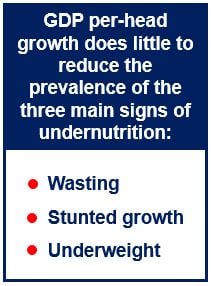Child undernutrition is barely improved when there is economic growth, researchers from Germany, Switzerland, the US and India reported in The Lancet Global Health after examining child growth patterns in thirty-six developing nations.
Among the poorest children in the world, economic growth was linked to either very small or no reductions in signs of undernutrition, such as wasting, underweight and stunting.
S.V. Subramanian, senior author and professor of population health and geography at the Harvard School of Public Health, said:
“These findings represent a potentially major shift in how we think about policies to reduce child undernutrition. “They emphasize that focusing on improving economic growth does not necessarily translate to child health gains.”
Lead author, Sebastian Vollmer, assistant professor of development economics at the University of Göttingen, adjunct assistant professor of global health at HSPH, said:
“Our study does not imply that economic development is not important in a general sense but cautions policymakers about relying solely on the trickle-down effects of economic growth on child nutrition.”
Child undernutrition not linked to GDP growth at country level

Vollmer and team gathered and analyzed data from several representative samples of children up to the age of three years taken from 121 health and demographic surveys that had been carried out in 36 middle- and low-income nations between 1990 and 2011.
They wanted to see what the effects of changes in GDP (gross domestic product) per head might be on the prevalence of wasting, underweight and stunting.
They found there was no association between GDP growth and the prevalence of undernutrition at a country level.
At an individual level, a 5% rise in GDP per head was linked to a tiny decline in the risk of stunting (0.4%), wasting (1.7%) and underweight (1.1%).
The researchers found no association between undernutrition rates among children in the poorest households and GDP per-head growth.
Why does GDP growth not improve child undernutrition?
The authors offered some explanations for the very weak link between economic growth and declines in child undernutrition:
- Wealth distribution is unequal when economies grow, with the poorest in society missing out on most of the benefits.
- Even among poor households with improved incomes, the extra money might not always be spend in ways that reduce childhood undernutrition.
- Standards of public services, such as clean water and vaccinations may not advance at the same time as GDP per-head growth, i.e. there is a time lag.
It is clear that direct interventions are critical in reducing the prevalence of child undernutrition.
In an Abstract in the journal, the authors concluded:
“A quantitatively very small to null association was seen between increases in per-head GDP and reductions in early childhood undernutrition, emphasizing the need for direct health investments to improve the nutritional status of children in low-income and middle-income countries.”

